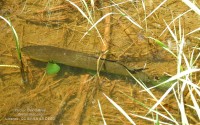Atlantic hookear sculpin
(Artediellus atlanticus)

Image source: Halvard Aas Midtun | inaturalist.org
Classification
General data
Artediellus atlanticus, the Atlantic hookear sculpin or hookhorn sculpin, is a species of marine ray-finned fish belonging to the family Cottidae.
Artediellus atlanticus has an elongated body which is thicker at the front and tapers to the tail with a moderately large mouth. The gill membranes are joined at the isthmus, there are no bony protuberances on the scales of the lateral line and the spine on the operculum is hooked upwards. The dorsal fina are supported by a total of 7 spines and 13 soft rays while the anal fin is supported by 11 soft rays.
The maximum published standard length is 15 cm (5.9 in), although 10.5 cm (4.1 in) is more typical.
Artediellus atlanticus lives in the North Atlantic Ocean and west Arctic ocean where it occurs from Greenland to Cape Cod in the northwestern Atlantic and from the Barents Sea and Greenland south through Iceland, Scandinavia, the Faroes south to northern Scotland and Ireland.
It is a demersal fish found on sandy or muddy substrates at depths between 35 and 900 m (115 and 2,953 ft).








